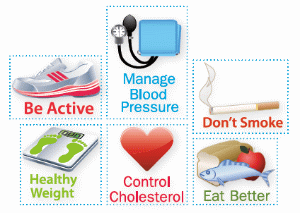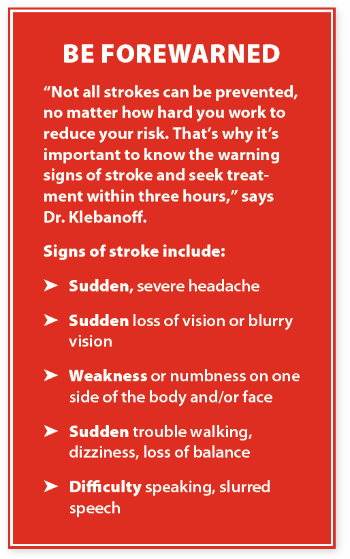 What You Can Do to
Prevent a Stroke What You Can Do to
Prevent a Stroke
Simple steps can have a major
impact on reducing your risk
Do you plan to start exercising to lose those 20 extra pounds? Have you resolved to get a handle on your blood pressure, high cholesterol, or smoking?
Start now! Taking control of these modifiable risk factors will lower your risk for stroke.
“Risk factor modification is essential for stroke prevention. And, while it's great to treat any risk factor, it's best to treat them all. We don't want you to take medication to lower your cholesterol—but not stop smoking,” says Louise Klebanoff, MD, vice chair of the Department of Neurology at Weill Cornell.
The importance of prevention
More than 53 percent of the 795,000 annual strokes in the U.S. occur in women. For nearly 77,000, the stroke is fatal.
When stroke doesn't kill, it is likely to leave a neurological deficit. “The inability to speak, walk, or care for oneself are possible outcomes and reasons stroke is a leading cause of disability and nursing home admissions,” says Dr. Klebanoff. “We would much rather prevent these events than deal with the consequences.”
Stroke risk in women
Certain risk factors are involved in 90 percent of strokes. Addressing these factors with medications and lifestyle changes can lower the risk and also blunt the effect of other risk factors specific to women. These include the use of oral contraceptives and hormone replacement therapy.
The American Heart Association and American Stroke Association recently issued guidelines for stroke prevention in women. Here are the top 10 risk factors to address:
 Hypertension. The higher your blood pressure, the higher your risk of stroke. The relationship is so strong that lowering blood pressure to normal is one of the most effective strategies for preventing stroke. A healthy diet, regular exercise, and medications may all help normalize blood pressure.
Hypertension. The higher your blood pressure, the higher your risk of stroke. The relationship is so strong that lowering blood pressure to normal is one of the most effective strategies for preventing stroke. A healthy diet, regular exercise, and medications may all help normalize blood pressure.
 Diet. Diets that are high in salt or low in fruits (particularly citrus), vegetables, and potassium increase stroke risk. So do high alcohol consumption, obesity, and poor nutrition.
Diet. Diets that are high in salt or low in fruits (particularly citrus), vegetables, and potassium increase stroke risk. So do high alcohol consumption, obesity, and poor nutrition.
High-salt diets often increase blood pressure, which can be worsened by lack of potassium. The Dietary Approaches to Stop Hypertension (DASH) diet was developed to lower blood pressure. And, a Mediterraneanstyle diet based on fish, legumes, fruits, vegetables, olive oil, and nuts has been shown to lower stroke risk.
  Physical inactivity. Physically active women have a 25 to 30 percent lower risk of stroke than inactive women. Guidelines recommend moderate-to-vigorous aerobic activity for 40 or more minutes a day on three or four days of the week. However, some activity is better than none.
Physical inactivity. Physically active women have a 25 to 30 percent lower risk of stroke than inactive women. Guidelines recommend moderate-to-vigorous aerobic activity for 40 or more minutes a day on three or four days of the week. However, some activity is better than none.
 Dyslipidemia. A high total cholesterol level is a risk factor for stroke in women of all ages. Treatment with statins can reduce this risk. The lower the LDL cholesterol, the lower the risk of stroke.
Dyslipidemia. A high total cholesterol level is a risk factor for stroke in women of all ages. Treatment with statins can reduce this risk. The lower the LDL cholesterol, the lower the risk of stroke.
 Obesity. Where fat is stored is more important than the total number of extra pounds. In different studies, abdominal fat and a higher waist-to-hip ratio increased the stroke risk in women.
Obesity. Where fat is stored is more important than the total number of extra pounds. In different studies, abdominal fat and a higher waist-to-hip ratio increased the stroke risk in women.
 Diabetes. Even when diabetes is well controlled, it's a risk factor for stroke.
Diabetes. Even when diabetes is well controlled, it's a risk factor for stroke.
 Smoking. The more cigarettes you smoke, the higher your risk of stroke. Smoking. The more cigarettes you smoke, the higher your risk of stroke.
 Migraine. Migraines are associated with stroke in women under age 45. Smoking and oral contraceptives further increase the risk.
Migraine. Migraines are associated with stroke in women under age 45. Smoking and oral contraceptives further increase the risk.
 Atrial fibrillation (AF). Having AF, an irregular heart rhythm, can increase the risk of stroke up to five times. If you have AF, discuss medical or surgical treatment with your doctor.
Atrial fibrillation (AF). Having AF, an irregular heart rhythm, can increase the risk of stroke up to five times. If you have AF, discuss medical or surgical treatment with your doctor.
 Certain heart conditions. Many heart conditions increase stroke risk. If you have had a heart attack or have any form of heart disease, ask your doctor what steps you can take to reduce the risk of having a stroke. Certain heart conditions. Many heart conditions increase stroke risk. If you have had a heart attack or have any form of heart disease, ask your doctor what steps you can take to reduce the risk of having a stroke.
Some may find the thought of making changes unpleasant. In reality, several of these risk factors are very easy to modify.
“High blood pressure should be treated and monitored. Atrial fibrillation should be treated with anticoagulants, which are significantly more effective than aspirin for stroke prevention. Smoking cessation should be addressed,” says Dr. Klebanoff. “All of these efforts are much easier than living with the aftereffects of stroke.” | 